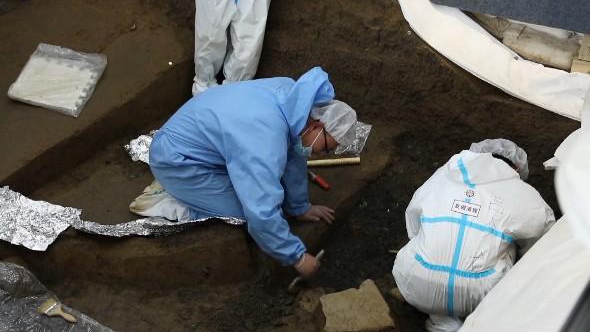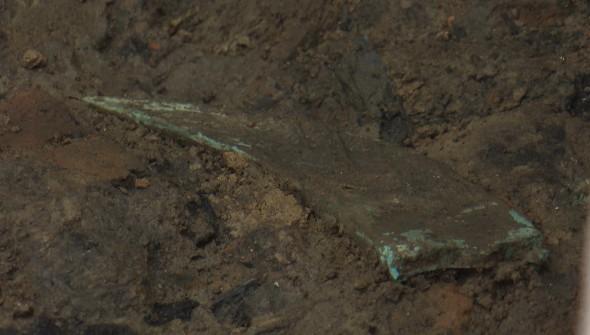
Archaeologists clear the debris at Sanxingdui No. 8 Pit, Guanghan City, southwest China's Sichuan Province, March 30, 2021. /CMG
Archaeologists clear the debris at Sanxingdui No. 8 Pit, Guanghan City, southwest China's Sichuan Province, March 30, 2021. /CMG
Two areas of the Sanxingdui No. 8 Pit were cleared of fills and dirt on Tuesday, revealing some bronze fragments.
Based on their patterns, experts believe that the pieces belong to the same sacrificial bronzeware, which they will attempt to put back together.
Sanxingdui is an archaeological site in Guanghan City, southwest China's Sichuan Province, which holds the remnants of the Shu Kingdom dating back as far back as 5,000 years ago.
More than 1,000 national treasures, including gold masks, bronzeware, jade tablets, ivory pieces, and a sacred tree, were unearthed in 1986 from two sacrificial pits at the site. A new round of excavation has uncovered six more pits, believed to be used for sacrificial purposes, and over 500 relics.
The newly unearthed bronze fragments from No. 8 Pit are located in the southern part of the ditch, while in the central area, most of the relics are made of clay and stone slabs. Experts believe that this specific layout was intentional on the part of the Shu people at the time.

A V-shaped fragment, unearthed from Sanxingdui No. 8 Pit in Guanghan City, southwest China's Sichuan Province, is believed to belong to a ritual vessel, March 30, 2021. /CMG
A V-shaped fragment, unearthed from Sanxingdui No. 8 Pit in Guanghan City, southwest China's Sichuan Province, is believed to belong to a ritual vessel, March 30, 2021. /CMG
Cai Ning from the School of Archaeology and Museology of Peking University is overseeing the excavation work of No. 8 Pit and said the unearthed bronze fragment is V-shaped and belongs to a ritual vessel.
No. 8 Pit is the largest of the six newly excavated trenches in Sanxingdui. Five large slabs of stone, two pieces of carbonized wood arranged in regular rows, and large lumps of earth were also dug out. They are thought to have been methodically and manually placed there.
Archaeologists see the placement of these debris as an important clue in their efforts to determine whether Sanxingdui is indeed a sacrificial site, and the No. 8 Pit has become the first to be clearly associated with sacrifice.
A third of No.8 Pit has been cleared to the ash layer so far, and artifacts are believed to be hidden some 30 centimeters deeper, which are expected to be reached by May.
Read more:
Live updates: China unveils new discoveries from Sanxingdui

